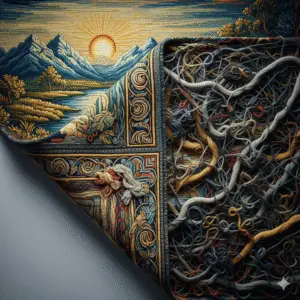
You’ve heard the phrase before, probably at a graduation speech or in a well-meaning greeting card: “Life is a tapestry.” It sounds nice, doesn’t it? A little sentimental, maybe. It’s one of those metaphors we nod at without really stopping to feel its weight, to truly unpack the profound truth it holds.
But I want you to actually picture it for a moment. Not a perfect, machine-made print you’d buy in a store. Close your eyes and imagine a real, hand-woven tapestry. The kind that’s vast and heavy, worked on for a lifetime. It’s draped over a giant loom, and you’re the weaver. You’ve been at this work since the day you were born.
Now, step a little closer. What do you see?
From a distance, it might look like a coherent image. A beautiful landscape, perhaps. But get right up next to it. Press your nose to the threads. This is where the magic—and the mess—truly lives.
The Front Side: The Picture Everyone Sees

This is the public face of your life. The curated highlight reel. It’s the vibrant thread of your college graduation, the golden strand of your wedding day, the rich, deep color of the birth of a child. It’s the bold, confident threads of career achievements, of buying a home, of that unforgettable vacation where the sunsets looked Photoshopped.
This is the side we present to the world. We smooth it out, hang it in the best light, and hope people admire the picture we’ve made. We point to the bright spots and say, “Look here, this is my life. This is the good part.”
And it is good. Those threads are real and beautiful and deserve to be celebrated.
But a tapestry is not made only of bright colors and perfect stitches. If it were, the image would be flat, uninspiring, and lacking any real depth. It would have no story.
The Back Side: The Tangled, Knotted, Beautiful Mess

This is the part we hide. The private side. The side only we, the weaver, truly know.
Now, flip your tapestry over. What’s there?
It’s a chaotic jumble of threads. There are knots—so many knots. Loose ends dangling everywhere. Threads that were cut short abruptly. Messy, tangled patches where the color changes suddenly and without reason. It looks nothing like the beautiful image on the front.
This is the truth of our weaving.
That dark, rough, knotted patch? That’s the year you lost someone you loved. The threads are grief and confusion, woven tightly together in a painful, dense block.
That long, tangled section where the color seems to go off-course? That’s the period of uncertainty, maybe after a lost job or a broken relationship, where you had no idea what pattern you were even trying to make anymore.
See that single, stark black thread running through a section that was otherwise bright yellow? That’s the persistent anxiety or sadness you carried even during what others perceived as a “happy” time.
This back side is messy. It’s awkward. It’s imperfect. We’re often ashamed of it. We want to cut away the dangling ends and hide the knots. We think, “If anyone saw this mess, they’d know I have no idea what I’m doing.”
But here’s the secret every master weaver knows: You cannot have the profound beauty of the front without the necessary mess of the back. The knots are not mistakes; they are what secure the threads. The tangles are evidence of a pattern changed, a course corrected. The loose ends are simply threads waiting to be woven into the next part of the design.
You Are the Weaver, But Not Always the Designer of your Life's Tapestry
We like to think we have complete control over this tapestry. We choose the colors! We hold the shuttle! But the humbling and liberating truth is that we are not the sole designers.
Life hands us threads we never asked for. A global pandemic. An unexpected diagnosis. A chance encounter that changes everything. A sudden loss. A surprise opportunity. These are threads of a color or texture we didn’t pick out, but they are thrust into our hands nonetheless.
Our job as the weaver isn’t to refuse them—that’s impossible. Our job is to take these unasked-for threads and integrate them into the ever-evolving design. That shocking red thread of crisis? Maybe it becomes the bold border that eventually gives the entire piece its strength. That dull, grey thread of a boring, tedious job? Woven throughout, it becomes the necessary background that makes the brighter threads pop.
Sometimes, we look at our work and all we can see is a single, ugly thread. We focus on it, obsess over it, believing it has ruined the entire piece. But from a broader perspective, that thread is essential. It provides contrast. It adds depth. It makes the tapestry true.
The Gift of Perspective: Stepping Back
This is the most important practice of our lives: learning to step back from the loom.
When you’re nose-to-thread, all you can see is the current knot you’re struggling with. It feels like the entire tapestry is just this one, impossible tangle. This is what anxiety and overwhelm feel like. We’re stuck in the mess of the back side, convinced the entire work is ruined.
But you must physically and mentally step back.
Look at the whole piece. See how that dark period from five years ago now serves as a powerful shadow that gives dimension to the mountain you wove next to it. See how that failed venture, that heartbreak, that seemingly wrong turn, created a fascinating detour in the path of your tapestry that makes the overall story far more interesting.
The threads of joy make no sense without the threads of sorrow. The threads of success are defined by the threads of struggle. You need them all.
Keep Weaving
So, what do we do when the thread in our hand is one we don’t want? When the pattern is confusing and the loom feels too big?
We just keep weaving.
We take the thread we’re given—be it brilliant joy or devastating grief—and we add it to the work. We trust that even if we can’t see the grand design now, it is emerging. We have to have faith in the process and in the cumulative beauty of including all of our experiences, not just the photogenic ones.
Your tapestry is unlike anyone else’s. Don’t compare your messy back side to someone else’s polished front side. Their tapestry has knots and tangles too, I promise you.
Your life, in all its glorious imperfection, is a masterpiece in progress. It is a complex, textured, and breathtakingly unique work of art. Honor the bright threads. But make peace with the knots. They are not flaws. They are the signature of a life truly, fully, and courageously lived.
Keep your shuttle moving. Add your thread. The picture is not finished yet. And the best part is, the most beautiful sections might still be to come.


